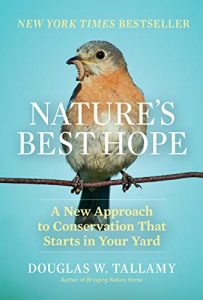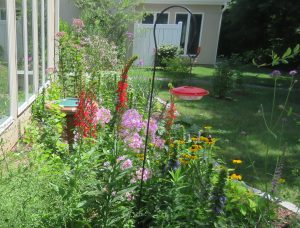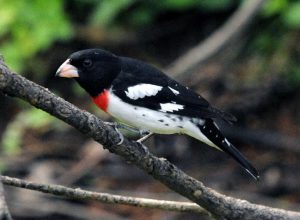Reviews by Edie Parnum
Nature’s Best Hope: A New Approach to Conservation That Starts in Your Yard by Douglas W. Tallamy
In his latest book, entomologist Doug Tallamy once  again inspires and informs us about gardening for nature. From Tallamy’s previous research and books, we understand native plants’ pivotal role in empowering the web of life. Insects, birds, mammals, and the rest of nature depend on native plants. Human beings, too, rely on the functioning of nature. We require the healthy air, clean water, and carbon-storing plants and soil that are nature’s products. Drawing on the latest research, he tells us how we can create an ecologically productive landscape in our own yards, inspire our neighbors, and help assure the health of the planet.
again inspires and informs us about gardening for nature. From Tallamy’s previous research and books, we understand native plants’ pivotal role in empowering the web of life. Insects, birds, mammals, and the rest of nature depend on native plants. Human beings, too, rely on the functioning of nature. We require the healthy air, clean water, and carbon-storing plants and soil that are nature’s products. Drawing on the latest research, he tells us how we can create an ecologically productive landscape in our own yards, inspire our neighbors, and help assure the health of the planet.
Most people assume that nature can be preserved on public lands. Conservation happens, we assume, somewhere else beyond our control. In fact, most of our country’s land is privately owned. We homeowners must create the landscapes where nature can thrive. Each of us can transform our own properties without the need to change government policy. Together we can create the “Hometown National Park”.
The suburbs offer the greatest opportunity to create this national park. Ninety-two percent of suburban land is lawn, a sterile landscape that doesn’t support birds or other wildlife By reducing the area devoted to turf grass, we can make room for native trees, shrubs, vines, perennials and grasses. We’re urged to plant lots of natives, not just a scattering of natives among the non-native ornamental exotics. Rather than isolated trees, plant groves of native trees and islands of native trees and shrubs.
The Hometown National Park can exist even in cities. In New York City the High Line is an abandoned elevated rail line that has been converted into a walkway surrounded by native plants. It is a popular destination to observe nature including birds, butterflies, and native bees. In Chicago, a tiny, isolated 1/10-acre garden is chockablock with native plants that have attracted 103 species of birds, including a woodcock.
To support nature on our properties, Tallamy urges us to garden for insects. Certain keystone native plants offer optimal value to wildlife because they support insects. Previously, Tallamy has urged us to plant oaks, willows, cherries, and other native woody species that host a great number of caterpillars, essential food for birds. Now we know fallen leaves are also important, because 94% of caterpillars pupate in the leaf litter or soil. We can use these leaves as mulch and grow native groundcovers to shelter these leaves.
Growing keystone native perennials is important for insects, too. For instance, goldenrods, normally considered weeds, are beautiful flowering plants that support 110 species of caterpillars. Thirty-five species of bees rely on the nectar and pollen of goldenrods. In addition, fifteen species of bees rear their young on goldenrod pollen.
This newest book by Tallamy provides valuable insights about gardening for nature. Readers not previously exposed to Tallamy’s ideas can benefit from first reading Bringing Nature Home, his groundbreaking book about gardening for wildlife with native plants. It includes a valuable list of the keystone woody plants that host the most caterpillars, plus a regional guide to recommended plants. The Living Landscape, co-authored with Rick Darke, provides comprehensive lists of native plants by regions and their ecological functions.
Tallamy’s writing is optimistic and empowering. This illustrated book gives us a practical, science-based guide to climate-wise gardening. By using native plants in our gardens, we can reverse declines in wildlife and support the earth-sustaining functions that store carbon and give us clean air and water. Our individual gardening practices plus those of our friends and neighbors can make a difference for the health of our planet.
What It’s Like to Be a Bird: From Flying to Nesting, Eating, Singing — What Birds Are Doing, and Why by David Allen Sibley
David Sibley is a renowned bird artist, so we  would expect beautiful images of birds in his newest book. Indeed, his birds seem to fly off the pages in the life-like illustrations. These are not static birds posing for their pictures. They fly, swim, eat, sing, preen, court, feed young, and more. They are always doing something, so we see what it’s like to be a bird.
would expect beautiful images of birds in his newest book. Indeed, his birds seem to fly off the pages in the life-like illustrations. These are not static birds posing for their pictures. They fly, swim, eat, sing, preen, court, feed young, and more. They are always doing something, so we see what it’s like to be a bird.
My favorite images show birds living their lives. A male Northern Cardinal offers food to his mate. A Common Yellowthroat feeds a Brown-headed Cowbird fledgling. To survive a snowstorm, Mourning Doves fluff their feathers and hunker down. The drawings illustrate key information. For instance, a Brown Pelican doesn’t use its pouch as a basket for carrying fish. Instead, Sibley, using both words and illustrations, clarifies its use as an underwater scoop to capture fish.
Using the latest ornithological research, Sibley also utilizes text to explain his illustrations. I wanted to know how a woodpecker extracts insects buried in the bark of a tree. The images and text show us a long, barbed tongue that can bend to reach into the crevices. When not in use, this exceptionally long tongue retracts to curve around the back of the bird’s brain. Then I became curious about the tongues of other birds. From the woodpecker page I was directed to information about hummingbird tongues. Thus, I become a curious traveler, following a trail of information through the book.
Sibley’s introduction aids the curiosity-driven navigation. All the brief illustrated essays are arranged into topics such as bird sight, sleep, growing new feathers, the digestive system, and many more. For instance, avoiding predators is a topic with 23 brief essays.
I plan to keep this book handy for regular use. It’s too big to take into the field or read in bed. Instead I’ll keep it next to the chair where I watch birds, referring to it when I have questions and then following the trail from one topic to another. I’ll discover gems of information and be impressed by the beauty, complexity, and richness of bird life.


